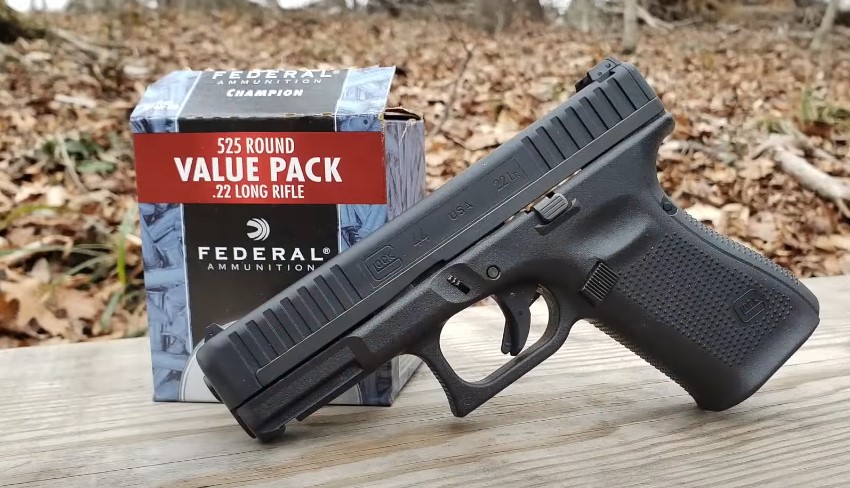Physical Address
304 North Cardinal St.
Dorchester Center, MA 02124
Physical Address
304 North Cardinal St.
Dorchester Center, MA 02124

The Glock 44 is a popular handgun, but like any firearm, it’s not without its quirks.
From jamming issues to misfires, these problems can be frustrating, especially for beginners.
Don’t worry most Glock 44 problems have simple fixes that anyone can handle.
This guide will walk you through the 7 most common issues and how to solve them quickly and easily.
Here are seven of the most common issues reported by Glock 44 owners, along with their causes and simple fixes.

A failure to feed occurs when a round does not properly enter the chamber from the magazine. You might find the bullet nose-diving into the feed ramp or getting stuck at an odd angle.
This is one of the most common complaints for any semi-automatic .22 LR firearm.
Cause:
This issue is most often caused by improper magazine loading or using incompatible ammunition.
The magazine’s follower and load-assist tab need to be managed correctly to ensure the rounds are stacked at the right angle for feeding.
Additionally, some .22 LR rounds with waxy coatings or unconventional bullet shapes can cause feeding problems.
Fixes:
When loading the magazine, pull the load-assist tab down just enough to insert one round at a time, allowing each cartridge to seat properly against the back of the magazine.
Avoid “rim lock,” where the rim of an upper cartridge gets stuck behind the rim of the one below it.
Stick to high-velocity, copper-plated round-nose ammunition, as these tend to perform most reliably in the G44.
Read Also: 8 Common Beretta A400 Xtreme Plus Problems (With Fixes)

Cause:
Weak or underpowered ammunition is the leading cause of FTEs. The Glock 44’s hybrid slide requires a certain amount of energy to cycle fully.
If the ammo doesn’t generate enough force, the slide won’t travel far enough back to properly eject the spent casing.
A dirty chamber or a weak extractor can also contribute to this problem.
Fixes:
Switch to a higher-velocity .22 LR ammunition, such as CCI Mini-Mag or Federal Automatch, which are known to function well in the G44.
Ensure your pistol is clean, paying special attention to the chamber and the extractor claw.
If the problem persists after cleaning and changing ammo, the extractor may need to be inspected by a qualified gunsmith.
Cause:
This can be caused by ammunition with hard primers or inconsistencies in the primer application during manufacturing.
It can also result from a dirty firing pin channel, which can slow the firing pin’s forward movement.
In rare cases, a weak firing pin spring could be the culprit.
Fixes:
First, try a different brand of ammunition, as some have harder primers than others.
If that doesn’t solve it, perform a thorough cleaning of the slide, focusing on the firing pin and its channel to remove any carbon buildup or debris.
You can do this by removing the slide backplate and taking out the firing pin assembly for a detailed cleaning.
Cause:
This issue is almost always related to the shooter’s grip.
If your thumb inadvertently rests on the slide stop lever, it can prevent the lever from engaging the notch in the slide after the last round is fired.
Underpowered ammunition can also be a factor if it prevents the slide from traveling fully to the rear.
Fixes:
Adjust your grip to ensure your thumb is clear of the slide stop lever.
This is a common issue for shooters accustomed to a “thumbs-forward” grip, especially on smaller frames. Practice your grip to build new muscle memory.
If your grip isn’t the problem, test with high-velocity ammunition to ensure the slide is cycling completely.
Cause:
The primary cause is pulling the load-assist tab down too far while loading. This allows the rounds to sit loosely and at an improper angle within the magazine body.
When the spring tension is released, the cartridges can shift, often resulting in “rim lock,” where the rim of one cartridge gets caught behind the one below it.
Fixes:
The key is to use the load-assist tab sparingly. Pull it down just enough to relieve spring pressure so you can insert one round at a time.
After inserting each round, allow the follower to push it up into place. This ensures the cartridges are stacked correctly, with each rim positioned in front of the one below it.
Cause:
The .22 LR cartridge is known for its variability, and every firearm barrel has its preferences.
Ammunition that works perfectly in one G44 might not perform as well in another.
Factors like bullet weight, velocity, and coating can all affect accuracy. A dirty barrel can also degrade accuracy over a shooting session.
Fixes:
Experiment with various brands and types of .22 LR ammunition to find what your specific pistol shoots best.
Buy small boxes of several different loads (e.g., CCI Standard Velocity, Federal Automatch, Aguila Super Extra) and test them from a bench rest.
Once you find a load that groups well, stick with it. Also, be sure to clean the barrel regularly to remove lead and carbon fouling.
Cause:
This can be caused by a manufacturing defect or, more commonly, by dry-firing the pistol without a snap cap or dummy round.
On many rimfire firearms, the firing pin can strike the edge of the chamber or barrel breech if a cartridge isn’t present, potentially causing damage.
While Glock states the G44 is safe to dry-fire, excessive dry-firing without protection is never recommended for rimfire guns.
Fixes:
If you suspect damage to your extractor or ejector, stop using the firearm immediately. These parts are critical for safe and reliable operation.
The best course of action is to contact Glock’s customer service or take the pistol to a certified Glock armorer for inspection and repair.
To prevent this issue, use a .22 LR snap cap when dry-firing.
High-velocity (1200+ FPS), 40-grain, copper-plated round-nose ammunition, like CCI Mini-Mags or Federal Automatch, tends to be the most reliable for both cycling and accuracy.
Yes, the Glock 44 is considered reliable for a .22 LR pistol, provided it is properly maintained and fed ammunition it likes. Most issues are ammo-related and easily solved.
Glock officially states that it is safe to dry-fire the G44. However, to be extra cautious and prolong the life of your firearm, it is always best practice to use a snap cap for extensive dry-fire practice.
Jamming is typically caused by three things: incompatible or low-powered ammunition, an improperly loaded magazine, or a dirty firearm. Address these three areas first to resolve most jamming issues.
It’s a good practice to clean your Glock 44 after every range session, or at least every 200-300 rounds. The .22 LR is a notoriously dirty round, and regular cleaning is key to reliability.
The Glock 44 is a fantastic pistol for training, learning, and low-cost shooting. While it can be sensitive to ammunition and maintenance, nearly all of its common problems are easily fixable.
By understanding the causes and applying these simple solutions, you can ensure your G44 runs as reliably as its centerfire cousins.
The key takeaways are to use high-quality, high-velocity ammunition, load your magazines with care, and keep your pistol clean.